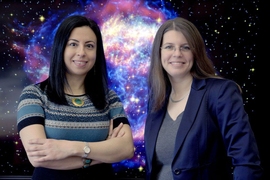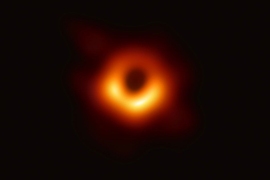Billions of years ago, in the center of a galaxy cluster far, far away (15 billion light-years, to be exact), a black hole spewed out jets of plasma. As the plasma rushed out of the black hole, it pushed away material, creating two large cavities 180 degrees from each other. In the same way you can calculate the energy of an asteroid impact by the size of its crater, Michael Calzadilla, a graduate student at the MIT Kavli Institute for Astrophysics and Space Research (MKI), used the size of these cavities to figure out the power of the black hole’s outburst.
In a recent paper in The Astrophysical Journal Letters, Calzadilla and his coauthors describe the outburst in galaxy cluster SPT-CLJ0528-5300, or SPT-0528 for short. Combining the volume and pressure of the displaced gas with the age of the two cavities, they were able to calculate the total energy of the outburst. At greater than 1054 joules of energy, a force equivalent to about 1038 nuclear bombs, this is the most powerful outburst reported in a distant galaxy cluster. Coauthors of the paper include MKI research scientist Matthew Bayliss and assistant professor of physics Michael McDonald.
The universe is dotted with galaxy clusters, collections of hundreds and even thousands of galaxies that are permeated with hot gas and dark matter. At the center of each cluster is a black hole, which goes through periods of feeding, where it gobbles up plasma from the cluster, followed by periods of explosive outburst, where it shoots out jets of plasma once it has reached its fill. “This is an extreme case of the outburst phase,” says Calzadilla of their observation of SPT-0528. Even though the outburst happened billions of years ago, before our solar system had even formed, it took around 6.7 billion years for light from the galaxy cluster to travel all the way to Chandra, NASA’s X-ray emissions observatory that orbits Earth.
Because galaxy clusters are full of gas, early theories about them predicted that as the gas cooled, the clusters would see high rates of star formation, which need cool gas to form. However, these clusters are not as cool as predicted and, as such, weren’t producing new stars at the expected rate. Something was preventing the gas from fully cooling. The culprits were supermassive black holes, whose outbursts of plasma keep the gas in galaxy clusters too warm for rapid star formation.
The recorded outburst in SPT-0528 has another peculiarity that sets it apart from other black hole outbursts. It’s unnecessarily large. Astronomers think of the process of gas cooling and hot gas release from black holes as an equilibrium that keeps the temperature in the galaxy cluster — which hovers around 18 million degrees Fahrenheit — stable. “It’s like a thermostat,” says McDonald. The outburst in SPT-0528, however, is not at equilibrium.
According to Calzadilla, if you look at how much power is released as gas cools onto the black hole versus how much power is contained in the outburst, the outburst is vastly overdoing it. In McDonald’s analogy, the outburst in SPT-0528 is a faulty thermostat. “It’s as if you cooled the air by 2 degrees, and thermostat’s response was to heat the room by 100 degrees,” McDonald explains.
Earlier in 2019, McDonald and colleagues released a paper looking at a different galaxy cluster, one that displays a completely opposite behavior to that of SPT-0528. Instead of an unnecessarily violent outburst, the black hole in this cluster, dubbed Phoenix, isn’t able to keep the gas from cooling. Unlike all the other known galaxy clusters, Phoenix is full of young star nurseries, which sets it apart from the majority of galaxy clusters.
“With these two galaxy clusters, we’re really looking at the boundaries of what is possible at the two extremes,” McDonald says of SPT-0528 and Phoenix. He and Calzadilla will also characterize the more normal galaxy clusters, in order to understand the evolution of galaxy clusters over cosmic time. To explore this, Calzadilla is characterizing 100 galaxy clusters.
The reason for characterizing such a large collection of galaxy clusters is because each telescope image is capturing the clusters at a specific moment in time, whereas their behaviors are happening over cosmic time. These clusters cover a range of distances and ages, allowing Calzadilla to investigate how the properties of clusters change over cosmic time. “These are timescales that are much bigger than a human timescale or what we can observe,” explains Calzadilla.
The research is similar to that of a paleontologist trying to reconstruct the evolution of an animal from a sparse fossil record. But, instead of bones, Calzadilla is studying galaxy clusters, ranging from SPT-0528 with its violent plasma outburst on one end to Phoenix with its rapid cooling on the other. “You’re looking at different snapshots in time,” says Calzadilla. “If you build big enough samples of each of those snapshots, you can get a sense how a galaxy cluster evolves.”









